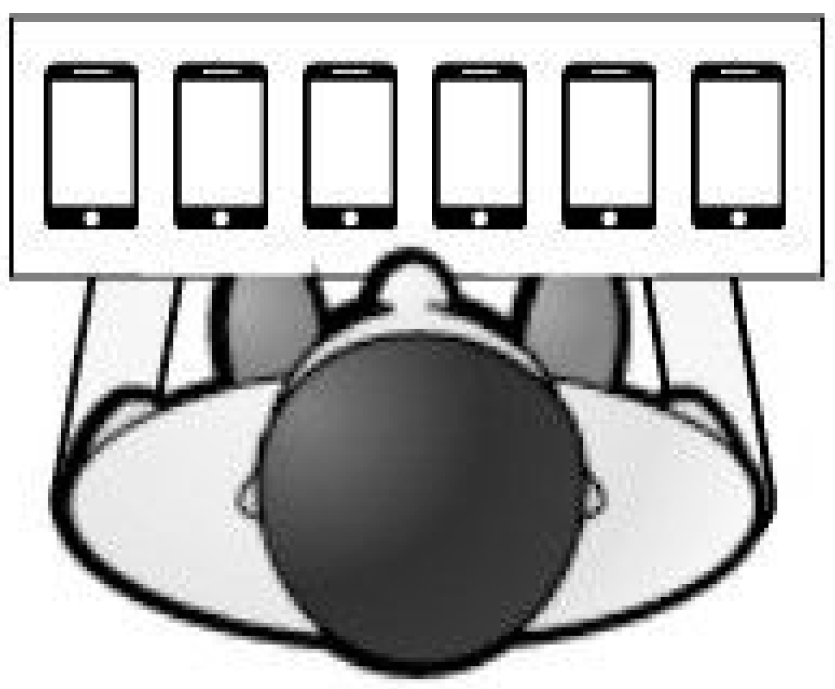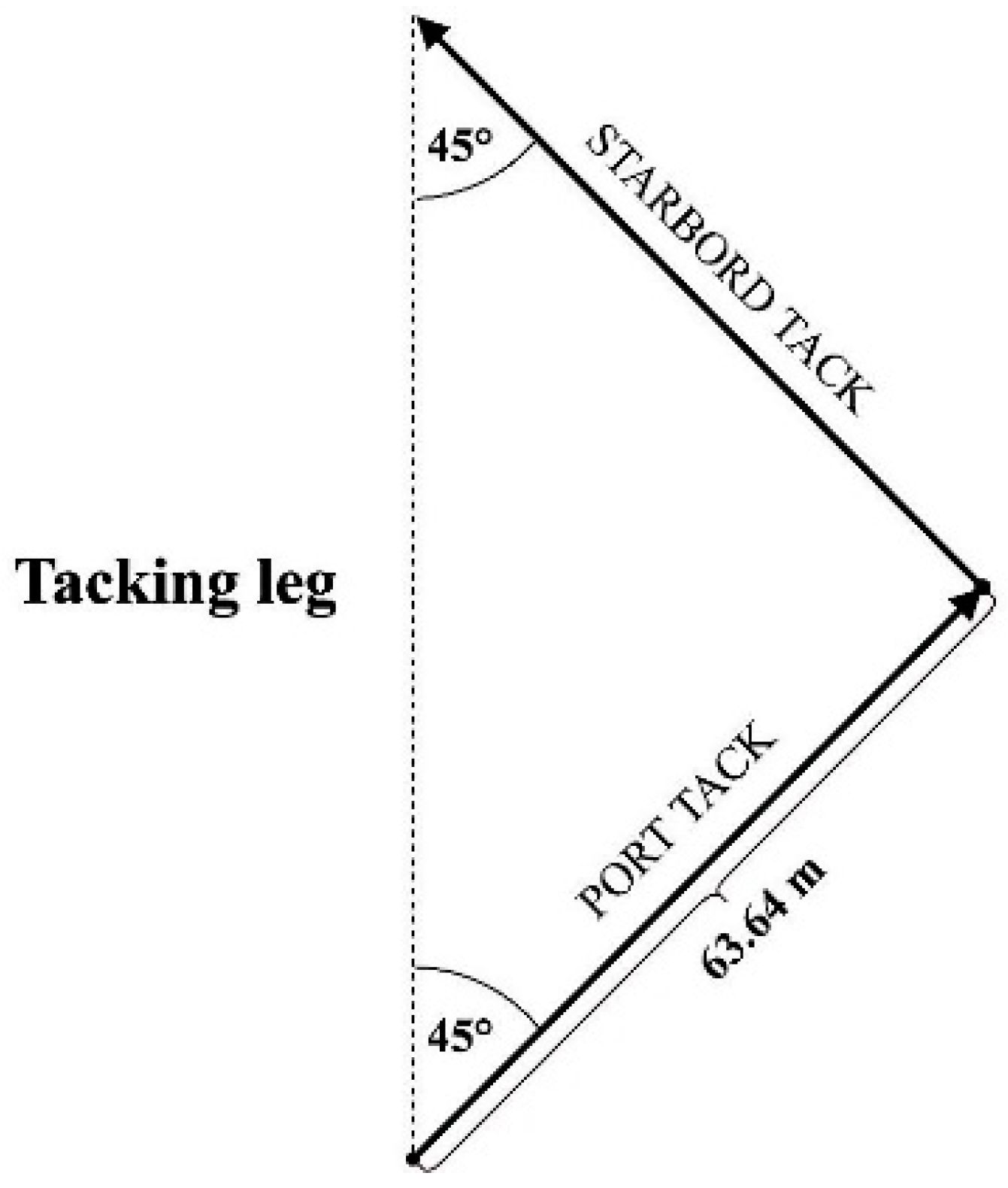Intra- and Inter-Device Reliability of the Change-of-Direction Angles Using a Smartphone Application for Sailing
Abstract
1. Introduction
2. Materials and Methods
2.1. General Procedure
- (a)
- Inter-device reliability was tested on the same day during one session (intra-trial). The total of six identical smartphones were tested simultaneously. This type of evaluation of reliability is related to the degree of agreement among raters—in this particular case, devices.
- (b)
- Intra-device reliability was tested in consecutive five sessions (inter-trial). Retest depicts variability depending on implemented procedures and reflects the stability of the phenomena [11]—in this particular case, it reflects the consistency in COD given by the same device across multiple trials.
2.2. Subject
2.3. Settings and Testing
2.4. Instrumentation
2.5. Software
2.6. Statistic Analysis
3. Results
4. Discussion
5. Conclusions
Author Contributions
Funding
Conflicts of Interest
References
- Bort-Roig, J.; Gilson, N.D.; Puig-Ribera, A.; Contreras, R.S.; Trost, S.G. Measuring and Influencing Physical Activity with Smartphone Technology: A Systematic Review. Sports Med. 2014, 44, 671–686. [Google Scholar] [CrossRef] [PubMed]
- Higgins, J.P. Smartphone Applications for Patients’ Health and Fitness. Am. J. Med. 2016, 129, 11–19. [Google Scholar] [CrossRef] [PubMed]
- Peart, D.J.; Balsalobre-Fernández, C.; Shaw, M.P. Use of Mobile Applications to Collect Data in Sport, Health, and Exercise Science: A Narrative Review. J. Strength Cond. Res. 2019, 33, 1167–1177. [Google Scholar] [CrossRef] [PubMed]
- Scott, M.T.; Scott, T.J.; Kelly, V.G. The Validity and Reliability of Global Positioning Systems in Team Sport: A Brief Review. J. Strength Cond. Res. 2016, 30, 1470–1490. [Google Scholar] [CrossRef]
- Benson, A.C.; Bruce, L.; Gordon, B.A. Reliability and Validity of a GPS-enabled IPhoneTM “app” to Measure Physical Activity. J. Sports Sci. 2015, 33, 1421–1428. [Google Scholar] [CrossRef]
- Cummins, C.; Orr, R.; O’Connor, H.; West, C. Global Positioning Systems (GPS) and Microtechnology Sensors in Team Sports: A Systematic Review. Sports Med. 2013, 43, 1025–1042. [Google Scholar] [CrossRef]
- Gordon, B.A.; Bruce, L.; Benson, A.C. Physical Activity Intensity can be Accurately Monitored by Smartphone Global Positioning System ‘app’. Eur. J. Sport Sci. 2016, 16, 624–631. [Google Scholar] [CrossRef]
- Balloch, A.S.; Meghji, M.; Newton, R.U.; Hart, N.H.; Weber, J.A.; Ahmad, I.; Habibi, D. Assessment of a Novel Algorithm to Determine Change-of-Direction Angles While Running Using Inertial Sensors. J. Strength Cond. Res. 2020, 34, 134–144. [Google Scholar] [CrossRef]
- Hess, B.; Farahani, A.Z.; Tschirschnitz, F.; von Reischach, F. Evaluation of Fine-Granular GPS Tracking on Smartphones. In Proceedings of the First ACM SIGSPATIAL International Workshop on Mobile Geographic Information Systems, Redondo Beach, CA, USA, 6 November 2012; pp. 33–40. [Google Scholar] [CrossRef]
- Philpott, A.B.; Henderson, S.G.; Teirney, D. A Simulation Model for Predicting Yacht match Race Outcomes. Oper. Res. 2004, 52, 1–16. [Google Scholar] [CrossRef]
- Thomas, J.R.; Nelson, J.K.; Silverman, S. Research Methods in Physical Activity; Human Kinetics: Champaign, IL, USA, 1995; ISBN 0-7360-5620-3. [Google Scholar]
- Tarnas, J.; Schaffert, N. Sonifikacja w żeglarstwie regatowym, Sonification in Sailing Regatta. In Diagnostics in Sport, Handbook for Modern Coaches; Kusy, K., Zieliński, J., Eds.; Akademia Wychowania Fizycznego w Poznaniu: Poznań, Poland, 2017; pp. 213–227. ISBN 978-836-474-717-5. [Google Scholar]
- Shrout, P.E.; Fleiss, J.L. Intraclass Correlation: Uses in Assesing Rater Reliability. Psychol. Bull. 1979, 86, 420–428. [Google Scholar] [CrossRef]
- Liljequist, D.; Elfving, B.; Roaldsen, K.S. Intraclass Correlation–A Discussion and Demonstration of Basic Features. PLoS ONE 2019, 14, e0219854. [Google Scholar] [CrossRef] [PubMed]
- Fleiss, J.L. Analysis of Data from Multiclinic Trials. Control. Clin. Trials 1986, 7, 267–275. [Google Scholar] [CrossRef]
- Specht, C.; Koc, W.; Smolarek, L.; Grządziela, A.; Szmagliński, J.; Specht, M. Diagnostics of the Tram Track Shape with the Use of the Global Positioning Satellite Systems (GPS/Glonass) Measurements with a 20 Hz Frequency Sampling. J. Vibroeng. 2014, 16, 3076–3085. [Google Scholar]
- Szot, T.; Specht, C.; Specht, M.; Dabrowski, P.S. Comparative Analysis of Positioning Accuracy of Samsung Galaxy Smartphones in Stationary measurements. PLoS ONE 2019, 14, e0215562. [Google Scholar] [CrossRef]
- Lai, P.; Li, C.; Chan, K.; Kwong, K. An Assessment of GPS and GIS in Recreational Tracking. J. Park Recreat. Adm. 2007, 25. Available online: https://js.sagamorepub.com/jpra/article/view/1387 (accessed on 4 April 2020).
- Castagna, O.; Brisswalter, J.; Lacour, J.R.; Vogiatzis, I. Physiological Demands of Different Sailing Techniques of the New Olympic Windsurfing Class. Eur. J. Appl. Physiol. 2008, 104, 1061–1067. [Google Scholar] [CrossRef]
- Vaitl, C.; Kunze, K.; Lukowicz, P. Does on-body Location of a GPS Receiver Matter? In Proceedings of the IEEE 2010 International Conference on Body Sensor Networks, Singapore, 7–9 June 2010; pp. 219–221. [Google Scholar] [CrossRef]
- Blunck, H.; Kjærgaard, M.B.; Toftegaard, T.S. Sensing and Classifying Impairments of GPS Reception on Mobile Devices. In Proceedings of the International Conference on Pervasive Computing, Berlin, Germany, 12–15 June 2011; Springer: Heidelberg, Germany, 2011; pp. 350–367. [Google Scholar] [CrossRef]
- Rawstorn, J.C.; Maddison, R.; Ali, A.; Foskett, A.; Gant, N. Rapid Directional Change Degrades GPS Distance Measurement Validity During Intermittent Intensity Running. PLoS ONE 2014, 9, e93693. [Google Scholar] [CrossRef]
- Duffield, R.; Reid, M.; Baker, J.; Spratford, W. Accuracy and Reliability of GPS Devices for Measurement of Movement Patterns in Confined Spaces for Court-based Sports. J. Sci. Med. Sport 2010, 13, 523–525. [Google Scholar] [CrossRef]
- Edgecomb, S.J.; Norton, K.I. Comparison of Global Positioning and Computer-based Tracking Systems for Measuring Player Movement Distance During Australian Football. J. Sci. Med. Sport 2006, 9, 25–32. [Google Scholar] [CrossRef]
- Coutts, A.J.; Duffield, R. Validity and Reliability of GPS Devices for Measuring Movement Demands of Team Sports. J. Sci. Med. Sport 2010, 13, 133–135. [Google Scholar] [CrossRef]
- Bergasa, L.M.; Almeria, D.; Almazán, J.; Yebes, J.J.; Arroyo, R. Drivesafe: An App for Alerting Inattentive Drivers and Scoring Driving Behaviors. In Proceedings of the 2014 IEEE Intelligent Vehicles Symposium Proceedings, Dearborn, MI, USA, 8–11 June 2014; IEEE: Ypsilanti, MI, USA, 2014; pp. 240–245. [Google Scholar]
- Lin, S.; Cheng, R.; Wang, K.; Yang, K. Visual localizer: Outdoor Localization Based on Convnet Descriptor and Global Optimization for Visually Impaired Pedestrians. Sensors 2018, 18, 2476. [Google Scholar] [CrossRef] [PubMed]



| Trial | ICC3,1 | 95% CI | ICC3,k | 95% CI |
|---|---|---|---|---|
| (Six smartphones were used in each trial) | ||||
| 1 | 0.95 | 0.90–0.97 | 0.99 | 0.98–1.0 |
| 2 | 0.97 | 0.94–0.99 | 0.99 | 0.99–1.0 |
| 3 | 0.97 | 0.94–0.98 | 0.99 | 0.98–1.0 |
| 4 | 0.98 | 0.97–0.99 | 0.99 | 0.99–1.0 |
| 5 | 0.96 | 0.94–0.98 | 0.99 | 0.99–1.0 |
| Smartphone | ICC3,1 | 95% CI | ICC3,k | 95% CI |
|---|---|---|---|---|
| (For each smartphone five trials were made) | ||||
| 1 | 0.98 | 0.96–0.99 | 0.99 | 0.99–1.0 |
| 2 | 0.99 | 0.99–1.0 | 1.0 | 1.0 |
| 3 | 0.93 | 0.88–0.97 | 0.99 | 0.97–0.99 |
| 4 | 0.96 | 0.92–0.98 | 0.99 | 0.98–1.0 |
| 5 | 0.96 | 0.93–0.98 | 0.99 | 0.98–1.0 |
| 6 | 0.96 | 0.94–0.98 | 0.99 | 0.99–1.0 |
© 2020 by the authors. Licensee MDPI, Basel, Switzerland. This article is an open access article distributed under the terms and conditions of the Creative Commons Attribution (CC BY) license (http://creativecommons.org/licenses/by/4.0/).
Share and Cite
Tarnas, J.; Schaffert, N.; Elegańczyk-Kot, H.; Kostański, L.; Stemplewski, R. Intra- and Inter-Device Reliability of the Change-of-Direction Angles Using a Smartphone Application for Sailing. Int. J. Environ. Res. Public Health 2020, 17, 3494. https://doi.org/10.3390/ijerph17103494
Tarnas J, Schaffert N, Elegańczyk-Kot H, Kostański L, Stemplewski R. Intra- and Inter-Device Reliability of the Change-of-Direction Angles Using a Smartphone Application for Sailing. International Journal of Environmental Research and Public Health. 2020; 17(10):3494. https://doi.org/10.3390/ijerph17103494
Chicago/Turabian StyleTarnas, Jacek, Nina Schaffert, Helena Elegańczyk-Kot, Leszek Kostański, and Rafał Stemplewski. 2020. "Intra- and Inter-Device Reliability of the Change-of-Direction Angles Using a Smartphone Application for Sailing" International Journal of Environmental Research and Public Health 17, no. 10: 3494. https://doi.org/10.3390/ijerph17103494
APA StyleTarnas, J., Schaffert, N., Elegańczyk-Kot, H., Kostański, L., & Stemplewski, R. (2020). Intra- and Inter-Device Reliability of the Change-of-Direction Angles Using a Smartphone Application for Sailing. International Journal of Environmental Research and Public Health, 17(10), 3494. https://doi.org/10.3390/ijerph17103494





